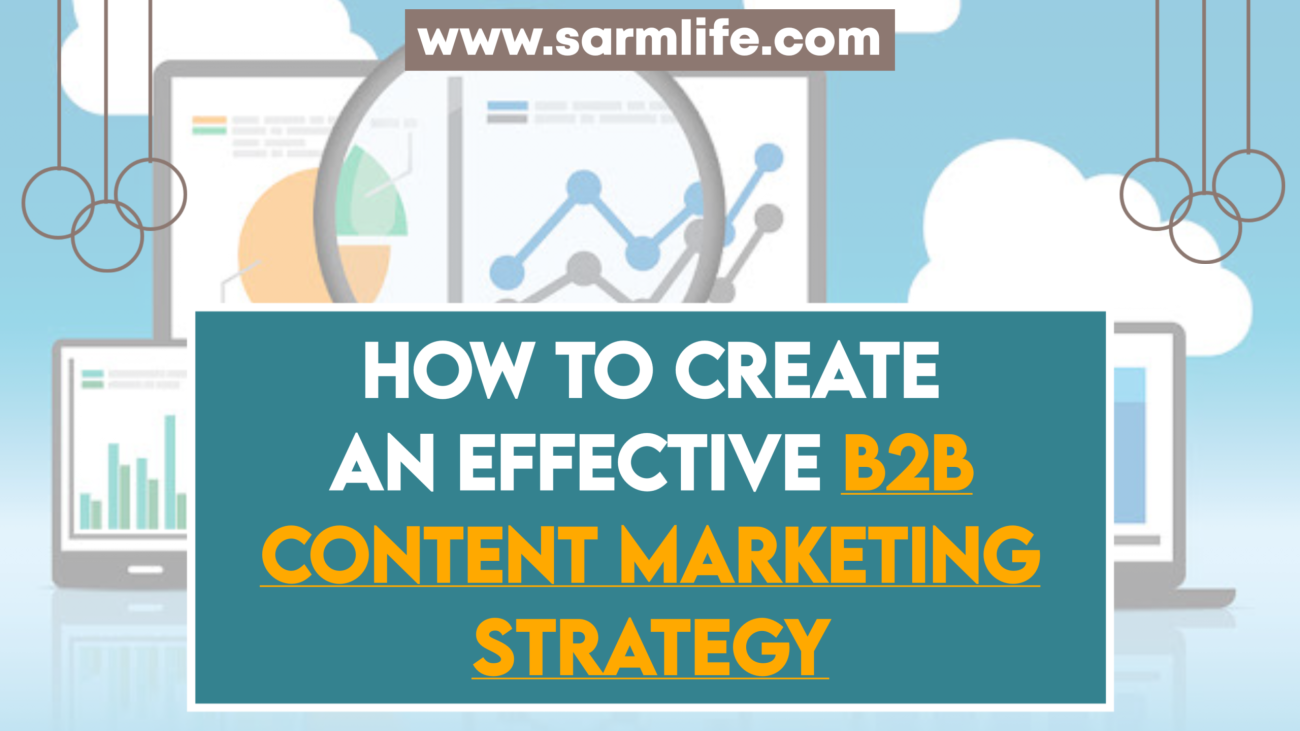Any business that wants to reach the right audience must have an effective content marketing strategy. When you create and distribute high-quality content, your business can attract potential customers, engage with them, build relationships, and drive sales.
However, creating an effective B2B (business-to-business) content marketing strategy can be challenging. There are several types of content businesses can create, and it can be challenging to know where to start.
Before we delve into creating an effective B2B content marketing strategy, I would like to take you through what a B2B business is, its key characteristics, and how it differs from B2C (business-to-consumer) businesses.
This is a crucial step to help you know if your business is a B2B business and if you need a B2C or a B2B content marketing strategy.
What are B2B businesses?
B2B, which means “business-to-business,” refers to companies/businesses that sell their goods or services to other businesses, not individual customers.
It implies that B2B businesses focus on meeting other companies’ specific needs and demands instead of targeting the general public.
Key characteristics of B2B businesses
Here are some characteristics of business-to-business:
- Larger transaction sizes
B2B transactions involve more money than B2C transactions, as businesses often purchase goods in bulk or require complex services.
- Longer sales cycles
B2B sales cycles can be much longer than B2C ones, as a more complex decision-making process is often involved. It may involve multiple stakeholders within the buying company, negotiations, and pilot projects.

Photo by Olivier Le Moal on iStock
- Focus on relationships
Building solid relationships with potential and existing customers is crucial in B2B, as trust and reliability are critical factors in business partnerships.
- Technical expertise
The complexity of B2B products and services is higher than that of B2C businesses, so salespeople and marketers need to have a strong understanding of the industry and the specific needs of their target customers.
- Emphasis on ROI
B2B businesses often demonstrate their products or services’ return on investment (ROI) to potential customers. This means they must focus on the quantifiable benefits their offerings can provide other businesses.
Examples of B2B businesses
Here are some typical examples of B2B businesses:
- Software companies
- Marketing agencies
- Manufacturers
- Suppliers
- Professional services firms
- Accounting Firms
- Logistics & Shipping
- Web Hosting & Cloud
- Cybersecurity
- Recruitment Agencies
RELATED POSTS:
5 REASONS WHY CONTENT MARKETING IS IMPORTANT FOR …
5 Importance of Blog Marketing for Business Growth – SARMLife
BENEFITS OF BLOGGING FOR BUSINESS IN 2024: Why you should start now! – SARMLife
5 Unique Tips to Maximize your Guest Blogging efforts – SARMLife
B2B vs. B2C businesses
Although they both have important roles to play in the economy, B2B and B2C businesses consider different factors.
Here’s a breakdown of their key differences:
| FACTORS | B2B | B2C |
| Target Audience | Other businesses with specific needs and demands. | Individual consumers with diverse preferences and motivations. |
| Sales Cycle | It can be longer and more complex, involving multiple decision-makers, negotiations, and pilot projects. | It can be shorter and simpler, often driven by impulse purchases or immediate needs. |
| Marketing | It focuses on logic, data, ROI, and building trust through industry expertise and case studies. | It appeals to emotions, personal desires, and brand image through creative channels and storytelling. |
| Product/Service Complexity | Often more technical and intricate, catering to specific business functions and challenges | Generally easier to understand and use, designed for mass appeal and everyday needs |
| Pricing | More flexible and negotiable, often based on volume discounts, contracts, and custom quotes | Fixed or standardized pricing that is influenced by competition and market trends |
| Customer Relationships | Long-term, strategic partnerships with a high emphasis on communication, support, and account management | Transactional or one-time, with less emphasis on individual relationships |
| Examples | Marketing agencies, accounting firms, software companies, manufacturers, and suppliers | Retail stores, restaurants, media companies, consumer goods brands, and service providers (e.g., hairdressers, dentists) |
INSERT A RELATED IMAGE

Photo by Campaign Creators on unsplash
Why you need a B2B content marketing strategy
Here are some significant reasons you need an effective B2B content marketing strategy:
a. To attract and engage potential customers
With a B2B content marketing strategy, you can create blog posts, infographics, webinars, and more that directly address your audience’s pain points, educate them on industry trends, and showcase your knowledge.
This will attract qualified leads who are already interested in what you have to offer, making them more receptive to your future sales efforts.
b. To increase brand awareness
Think of content as a megaphone for your brand. You can spread brand awareness beyond your website by consistently creating high-quality and relevant content.
Your content also gets shared on several social media platforms. It is discoverable through search engines, making your brand visible to a broader audience and establishing you as an authority in your field.
c. To drive sales
Content marketing is more than just awareness; it’s about lead generation, nurturing leads, and guiding them through your sales funnel.
By crafting compelling content that addresses each stage of the buyer’s journey, you can educate potential customers about your product, showcase its benefits, and ultimately convince them why it’s the perfect solution for their needs.
d. To improve your search engine ranking
Search engines love fresh and relevant content. A consistent content marketing strategy ensures your website stays active and brimming with valuable information.
Potential clients will find you more quickly if you employ this tactic, increasing your search engine ranking and keeping visitors interested.

Photo by KTStock on iStock
e. To create a community around your brand
Content marketing isn’t just a one-way street. By producing interactive content, holding Q&A sessions, and participating in online communities, you can build a loyal fan base for your company.
This fosters a sense of belonging and trust, turning your customers into advocates who champion your brand and spread the word organically.
How to create an effective B2B content marketing strategy
I’ve seen people repeatedly get it wrong with their content marketing strategies.
One of the most important things to note when developing any content marketing strategy is that it should be tailored to your type of business. So, your B2B content marketing strategy will only be effective if your business is B2B.
And even at that, you also need to streamline your B2B content marketing strategy to suit your exact niche.
Here are some more detailed tips on creating an effective B2B content marketing strategy:
1. Define your goals.
The goal of your content marketing strategy needs to be defined. For example, do you want to increase visibility, drive sales, or generate leads?
Before diving headfirst into content creation, take a moment to map out your aspirations. Having clear goals helps you tailor your content and measure success later on.
Once you have identified your objectives, you can create content to help you achieve them.
2. Identify your target audience.
Who are you creating content for?
Picture your ideal customer. Who are they? What are their challenges and pain points? What kind of information do they seek?
Understanding your target audience like this helps you create content that aligns with their needs and interests, ensuring it resonates and engages them effectively.
3. Choose the proper content formats.
You can create different types of content, including blog posts, infographics, ebooks, and case studies.
Variety is the spice of content! Don’t limit yourself to just blog posts. Explore different formats like white papers, infographics, webinars, podcasts, or short videos.
Choose the content formats that resonate with your target audience and the type of information you want to convey when selecting.
4. Create high-quality content.
Quality is king in the content kingdom. Your content’s quality, research, writing, and engagement should be high. It should also be optimized for search engines.
Rather than creating multiple pieces of content to put out to your audience, focus on offering value to them.
Be it data-driven insights, expert opinions, or practical tips, ensure your content is informative, actionable, and stands out from the crowd.
5. Promote your content.
Creating great content isn’t enough; you need to get it in front of the right eyeballs!
Once you have created high-quality content, you need to promote it so people can find it.
Utilize social media, email marketing, guest blogging, and industry forums to promote your content actively. Leverage search engine optimization (SEO) strategies to improve your website’s visibility and attract organic traffic.
6. Measure your results.
Data is your friend! It is crucial to track your results to see what is working and what is not.
Track key metrics like website traffic, engagement rates, lead generation, and conversions to understand your content marketing performance.
You can continuously enhance the effectiveness of your content strategy by using this data to fine-tune your approach and determine what works best.

Photo by Thapana Onphalai on iStock
Conclusion
Creating an effective B2B content marketing strategy takes time and effort but is worth it in the long run.
By consistently creating and distributing high-quality content, businesses can draw in potential customers, engage them, build relationships, and drive sales.
If you are serious about growing your B2B business, implement the tips outlined in this blog post today.
READ ALSO: How to choose the best blogging platform for your blog in 2024 – SARMLife


















